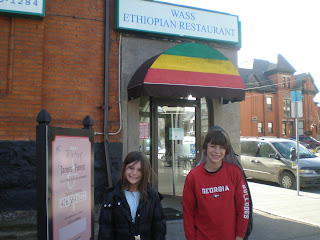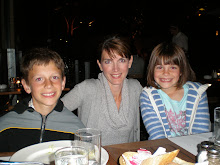



When many of us think of Ethiopia we think of the song “We Are the World” and the 1980s famine. My mother was working on the Ethiopian Desk at the State Department in Washington D.C. during that time. She took a trip to one of the famine camps in Ethiopia and she got violently ill from food poisoning, of all things.
Later, when I was in college, my friend, Karla, and I visited my parents in D.C. and we went out for Ethiopian food. For Karla and me, it was our first experience with this cuisine and we both felt a little nauseous when we all dug into a communal plate with our hands, using only the injera bread to pick up pureed beans and bits of meat. It wasn’t an experience we were anxious to repeat.
In fact, I never did go back to an Ethiopian restaurant until recently with Kevin and the kids for my Eat Planet project. There were quite a few Ethiopian restaurants to choose from in the Toronto area, but because of location we chose an establishment called Wass, a new Ethiopian restaurant in Hamilton.
The restaurant was dark and it smelled like cleaning solution. Our waitress, whom I’m guessing was the owner, was very friendly and talkative. She told us that coffee originated in Ethiopia and, if we wanted, she would perform a coffee preparation ceremony. The menu was extensive with lots of explanations and glossy photographs. There was even a detailed description on how to eat with the injera bread. It’s the only restaurant I’ve been to that came with an instruction manual.
I was very interested in the injera bread since I had recently tried to make it myself. The waitress seemed very happy about this but seemed confused when I told her I used teff flour. Because of my interest, I’m assuming, she brought us a free dish to try, chicken with Berbere sauce. It was delicious, better than any thing we ordered for ourselves. We had ordered a lamb dish and a vegetarian combo.
Berbere spice is the key ingredient in most cuisines in Ethiopia and Eritrea. It’s a mixture of spices usually including ginger, fenugreek, cumin, allspice, cloves and cardamon. Sometimes spices are included that are not common in the Western world, but are grown in Ethiopia, like long pepper. The waitress told us that a friend of hers traveled to Ethiopia and came back to Canada with big bags of the Berbere spice. Apparently, this coveted spice was in our chicken dish.
“Many vegetables and fruits grow in Ethiopia,” our waitress assured us. Every time she said the word Ethiopia it sounded like Utopia. “But the government is corrupt,” she said and laughed uneasily. Her country is still synonymous with famine and war.
When I asked her if Ethiopia was doing better, she shrugged. “I’ve never been there. But I want to go.”
Later, a couple of young women walked in and we lost our waitress. She tended to her new customers and then disappeared into the kitchen. We waited a while for our check, and then finally, the kids and I had to go sit in the car because our meter ran out.
The food was good, better than I remembered. But, still, when thinking of Ethiopia the tune of “We Are the World,” pops in my head and I wonder, after all this time, if things have really changed.

Hey glad you tried it, hopefully the kids enjoyed it and it was decent experience :)
ReplyDeleteAs of politics, proximity to the middle east and Realpolitik of big powers ensures perpetual and endless madness in the area.
http://www.slate.com/id/2178793/